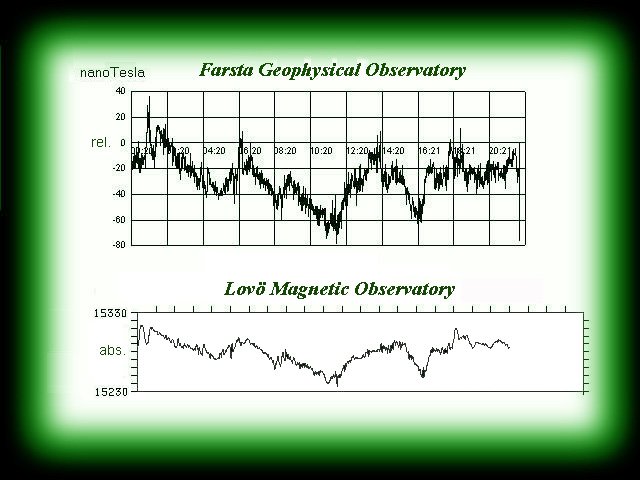
The graph shows what could be achieved in an urban area (Farsta Geophysical Observatory), compared with a professional magnetic observatory (Lovö Magnetic Observatory) . Farsta is located in the town of Stockholm. Lovö is just outside the city proper. The vertical (peak to peak) amplitude is 80 nT (nanoTesla) in the Lovö recording. Displayed are 22 hours of the 12´th of November, 2000. The magnetic noiselevel is high at the Farsta location, but significant magnetic events are readily caught by the magnetometer. A much lower noiselevel prevails at Brandbergen Magnetic Observatory.
This particular day, the magnetic activity was "quiet to unsettled", e.g. no Aurora was to be expected. When an Aurora is anticipated, the amplitude should change, well over 200 nT within a short timeframe (minutes). This condition is named "major magnetic storm" or "severe magnetic storm". It is, however, latitude dependent. The probability of storming increases with the latitude. In Stockholm one can expect an Aurora once a month, averaged over a typical solarcycle.
My design is centered around an ordinary compass. The needle is turned from the
normal north-south alignment to an east-westerly orientation by an external local magnetic
field. Now the global and local field is equal. If there is a small change of the global
part (which we are interested in) the needle will swing somewhat out of the east-westerly
direction. If you sense the position of the tip of the needle (with an opto-electrical
device) and allow this deviation to be corrected by the local magnetic field to again
equal the global field, you end up with a magnetometer!
We measure the voltage over the solenoid that generates the local magnetic field. It
should be recorded with either a pen-recorder or a PC supplied with an A/D-converter.
There is a "must" to have some recording device because the instantaneous
magnetic value is of no significance unless you know its history. We are more interested
in the changes of the magnetic field strength, rather than the absolute value of it.
A step by step instruction how to assemble this magnetometer has appeared in Sky &
Telescope, Oct 1993.